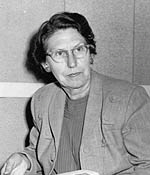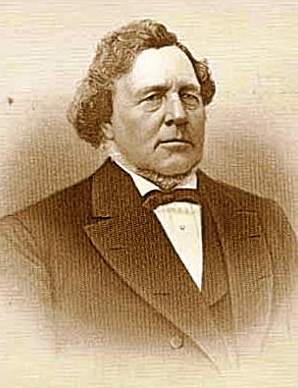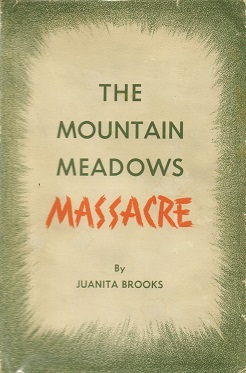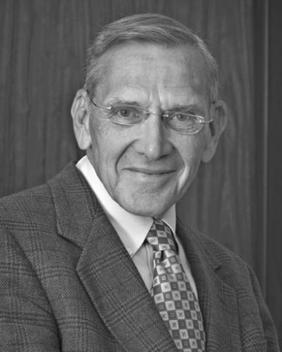
The Mountain Meadows Massacre was a series of attacks during the Utah War that resulted in the mass murder of at least 120 members of the Baker–Fancher emigrant wagon train. The massacre occurred in the southern Utah Territory at Mountain Meadows, and was perpetrated by settlers from the Church of Jesus Christ of Latter-day Saints involved with the Utah Territorial Militia who recruited and were aided by some Southern Paiute Native Americans. The wagon train, made up mostly of families from Arkansas, was bound for California, traveling on the Old Spanish Trail that passed through the Territory.

John Doyle Lee was an American pioneer, and prominent early member of the Latter Day Saint Movement in Utah. Lee was later convicted of mass murder for his complicity in the 1857 Mountain Meadows Massacre and sentenced to death. In 1877, he was executed by firing squad at the site of the massacre.

Juanita Pulsipher Brooks was an American historian and author, specializing in the American West and Mormon history. Her most notable contribution was her book related to the Mountain Meadows Massacre, to which her grandfather Dudley Leavitt was sometimes linked, and which caused tension between her and the church authorities. She also made significant archival contributions in the form of collected pioneer diaries documenting early Mormon history in the Dixie, Utah area. Brooks remained a faithful believer throughout her life.

George Albert Smith was an early leader in the Latter Day Saint movement. He served in the Quorum of the Twelve Apostles and as a member of the First Presidency of the Church of Jesus Christ of Latter-day Saints.

Blood atonement is a disputed doctrine in the history of Mormonism, under which the atonement of Jesus does not redeem an eternal sin. To atone for an eternal sin, the sinner should be killed in a way that allows his blood to be shed upon the ground as a sacrificial offering, so he does not become a son of perdition. The largest Mormon denomination, the Church of Jesus Christ of Latter-day Saints, has denied the validity of the doctrine since 1889 with early church leaders referring to it as a "fiction" and later church leaders referring to it as a "theoretical principle" that had never been implemented in the LDS Church.

The Baker–Fancher party was a group of American western emigrants from Marion, Crawford, Carroll, and Johnson counties in Arkansas, who departed Carroll County in April 1857 and "were attacked by the Mormons near the rim of the Great Basin, and about fifty miles from Cedar City, in Utah Territory, and that all of the emigrants, with the exception of 17 children, were then and there massacred and murdered" in the Mountain Meadows massacre. Sources estimate that between 120 and 140 men, women and children were killed on September 11, 1857, at Mountain Meadows, a rest stop on the Old Spanish Trail, in the Utah Territory. Some children of up to six years old were taken in by the Mormon families in Southern Utah, presumably because they had been judged to be too young to tell others about the massacre.
Mormons have experienced significant instances of violence throughout their history as a religious group. In the early history of the United States, violence was used as a form of control. Mormons faced persecution and forceful expulsion from several locations. They were driven from Ohio to Missouri, and from Missouri to Illinois. Eventually, they settled in the Utah Territory. These migrations were often accompanied by acts of violence, including massacres, home burnings, and pillaging.
Mormon public relations have evolved with respect to the Mountain Meadows Massacre since it occurred on September 11, 1857. After a period of official public silence concerning the massacre, and denials of any Mormon involvement, The Church of Jesus Christ of Latter-day Saints took action in 1872 to excommunicate some of the participants for their role in the massacre. Since then, the LDS Church has consistently condemned the massacre, though acknowledging involvement by some local Mormon leaders.

In Mormonism, a penalty is a specified punishment for breaking an oath of secrecy after receiving the Nauvoo endowment ceremony. Adherents promised they would submit to execution in specific ways should they reveal certain contents of the ceremony. In the ceremony participants each symbolically enacted three of the methods of their execution: throat slitting, heart removal, and disembowelment. These penalties were first instituted by Joseph Smith in 1842, and further developed by Brigham Young after Smith's death. The penalties were similar to oaths made as part of a particular rite of Freemasonry practiced in western New York at the time the endowment was developed. During the 20th century, the largest Mormon denomination, The Church of Jesus Christ of Latter-day Saints, gradually softened the graphic nature of their penalties, and in 1990, removed them altogether from its version of the ceremony. Other Mormon denominations continue to have the penalties as part of their temple oaths.
The Mountain Meadows Massacre was caused in part by events relating to the Utah War, an armed confrontation in Utah Territory between the United States Army and Mormon Settlers. In the summer of 1857, however, Mormons experienced a wave of war hysteria, expecting an all-out invasion of apocalyptic significance. From July to September 1857, Mormon leaders prepared Mormons for a seven-year siege predicted by Brigham Young. Mormons were to stockpile grain, and were prevented from selling grain to emigrants for use as cattle feed. As far-off Mormon colonies retreated, Parowan and Cedar City became isolated and vulnerable outposts. Brigham Young sought to enlist the help of Indian tribes in fighting the "Americans", encouraging them to steal cattle from emigrant trains, and to join Mormons in fighting the approaching army.
Mormon theology has long been thought to be one of the causes of the Mountain Meadows Massacre. The victims of the massacre, known as the Baker–Fancher party, were passing through the Utah Territory to California in 1857. For the decade prior the emigrants' arrival, Utah Territory had existed as a theocracy led by Brigham Young. As part of Young's vision of a pre-millennial "Kingdom of God," Young established colonies along the California and Old Spanish Trails, where Mormon officials governed as leaders of church, state, and military. Two of the southernmost establishments were Parowan and Cedar City, led respectively by Stake Presidents William H. Dame and Isaac C. Haight. Haight and Dame were, in addition, the senior regional military leaders of the Mormon militia. During the period just before the massacre, known as the Mormon Reformation, Mormon teachings were dramatic and strident. The religion had undergone a period of intense persecution in the American mid-west.
The pursuit of the perpetrators of the Mountain Meadows massacre, which atrocity occurred September 11, 1857, had to await the conclusion of the American Civil War to begin in earnest.
The conspiracy and siege of the Mountain Meadows Massacre was initially planned by its Mormon perpetrators to be a short "Indian" attack, against the Baker–Fancher party. But the planned attack was repulsed and soon turned into a siege, which later culminated in the massacre of the remaining emigrants, on September 11, 1857.
The Mountain Meadows massacre was a series of attacks on the Baker–Fancher emigrant wagon train, at Mountain Meadows in southern Utah. The attacks culminated on September 11, 1857 in the mass slaughter of the emigrant party by the Iron County district of the Utah Territorial Militia and some local Indians.

The Mountain Meadows Massacre (1950) by Juanita Brooks was the first definitive study of the Mountain Meadows Massacre.

Blood of the Prophets: Brigham Young and the Massacre at Mountain Meadows (2002) by Will Bagley is a history of the Mountain Meadows massacre. The work updated Juanita Brooks' seminal history The Mountain Meadows Massacre, and remains one of the definitive works on the topic.
Richard Eyring "Rick" Turley Jr. is an American historian and genealogist. He previously served as both an Assistant Church Historian of the Church of Jesus Christ of Latter-day Saints and as managing director of the church's public affairs department.
In 1857, at the time of the Mountain Meadows Massacre, Brigham Young, was serving as President of the Church of Jesus Christ of Latter-day Saints and as Governor of Utah Territory. He was replaced as governor the following year by Alfred Cumming. Evidence as to whether or not Young ordered the attack on the migrant column is conflicted. Historians still debate the autonomy and precise roles of local Cedar City LDS Church officials in ordering the massacre and Young's concealing of evidence in its aftermath. Young's use of inflammatory and violent language in response to a federal expedition to the territory added to the tense atmosphere at the time of the attack. After the massacre, Young stated in public forums that God had taken vengeance on the Baker–Fancher party. It is unclear whether Young held this view because of a possible belief that this specific group posed a threat to colonists or that they were responsible for past crimes against Mormons. According to historian William P. MacKinnon, "After the war, Buchanan implied that face-to-face communications with Brigham Young might have averted the Utah War, and Young argued that a north–south telegraph line in Utah could have prevented the Mountain Meadows Massacre."

Ronald Warren Walker was an American historian of the Latter Day Saint movement and a professor at Brigham Young University (BYU) and president of the Mormon History Association. His work, acclaimed by the Mormon History Association, dealt with the Godbeites, the Utah War, and the Mountain Meadows Massacre, among other topics.
Robert H. Briggs is a Fullerton, California, lawyer and independent historian. As of 2010, Briggs's area of historical research related to violence in frontier Utah, in particular the Mountain Meadows Massacre of 1857.












